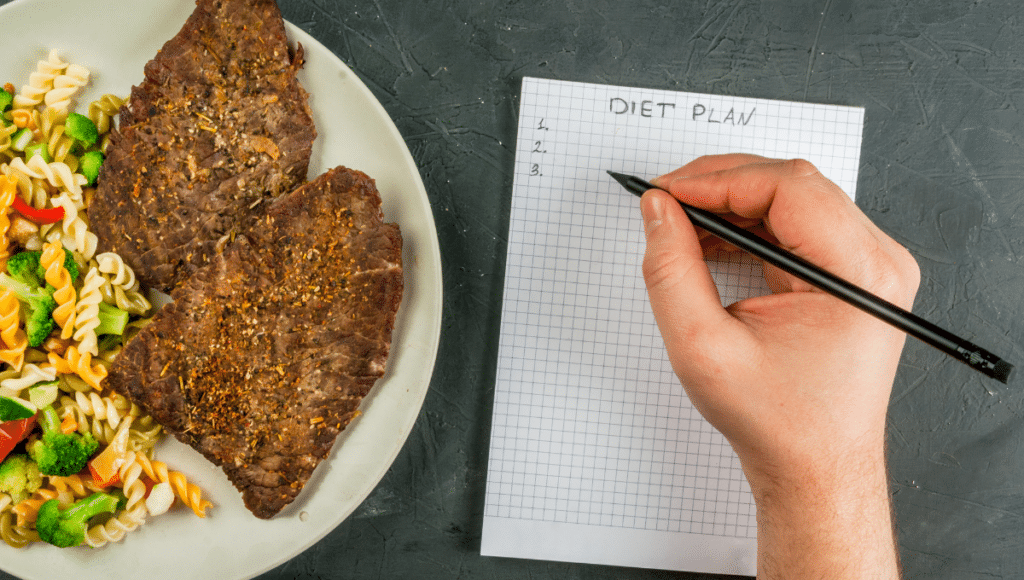Cutting weight is the process of losing body weight to meet the weight limits of a specific division or personal goal. The term is commonly used by athletes, fitness enthusiasts, bodybuilders, and powerlifters.
However, it is crucial to understand that cutting weight can be dangerous if done incorrectly. Losing too much weight too quickly can lead to dehydration, electrolyte imbalances, and other health complications.
Therefore, it’s essential to understand the specifics of cutting weight and proceed cautiously. Here’s your complete guide to cutting weight.
Jump to:
The Science Behind Cutting Weight
Cutting weight involves consuming fewer calories than your body burns, leading to weight loss. It’s a common practice for wrestlers, combat sports fighters, and fitness enthusiasts.
That said, most individuals don’t need to undergo the rapid weight loss methods athletes use to compete in specific weight classes. Instead, you can shed weight through diet and exercise routines.
Caloric Deficit
The human body needs a certain amount of energy, measured in calories, to maintain essential functions like breathing, circulation, and digestion. This energy requirement is the basal metabolic rate (BMR).
A calorie deficit occurs when an individual consumes fewer calories than they burn. In other words, it’s a condition where the body burns more calories than it takes in through food or drink. If a calorie deficit is sustained over a period of time, it can result in weight loss.
This differs from a caloric surplus, which includes eating more calories than you burn to gain weight.
Consuming fewer calories than your body needs to function requires your body to use energy from stored fat and muscle tissue. This results in the body breaking down fat and muscle tissue for energy, resulting in weight loss.
Calorie deficits can be achieved through various methods, like reducing calorie intake, increasing physical activity, or a combination of the two.
How Long It Takes to Cut Weight
The length of time it takes to cut weight varies on several factors, like your starting weight, desired results, methods used, and your overall health and fitness levels.
It is typically recommended to aim for gradual and sustainable weight loss of around 1-2 pounds per week. Meaning if you want to lose 10 pounds, it may take approximately 5-10 weeks to achieve these results through a calorie deficit and increased physical activity.
The Risks Associated With Cutting Weight
Although cutting weight is typical for bodybuilders, athletes, and fitness enthusiasts, there are a few risks to be aware of. Calorie deficits can potentially cause issues if you have pre-existing health conditions. A few points to be mindful of include the following:
- Type 2 Diabetes
- Kidney Issues
- High or Low Blood Pressure
It’s best to consult a healthcare professional before beginning a calorie-deficit diet, regardless if you have pre-existing conditions or not. A trusted professional can provide you with a plan to ensure you meet your goals safely and effectively.
Dehydration
Some cutting methods can lead to dehydration. Dehydration happens when the body loses more water than it takes in.

This causes a reduction in blood volume and a decrease in the body’s ability to regulate temperature. Side effects like dizziness, fatigue, nausea, and headaches, are also common.
Electrolyte Imbalances
Electrolytes are essential to help regulate bodily functions, such as muscle contractions, nerve impulses, and fluid balance. Cutting weight can cause electrolyte imbalances, leading to muscle cramps, fatigue, and in rare cases, seizures, and cardiac arrest.
Nutrient Deficiencies
Depending on your diet, cutting weight may also lead to nutrient deficiencies. Cutting weight can reduce your intake of certain food groups, limiting the nutrients you consume. Nutrient deficiencies may lead to symptoms like fatigue, weakness, and other health issues.
Impaired Performance
Cutting weight puts your body in a state where it doesn’t have the optimal amount of energy to perform at its best. This can impair your strength, endurance, agility, and concentration. If you’re an athlete, this can lead to a decreased ability to compete effectively and increase your chances of injury.
Long-term Health Effects
Cutting weight may lead to long-term health complications if performed incorrectly or repeatedly to an extreme degree. Some issues include decreased bone density, increased chance of injury, and a higher chance of developing eating disorders.
Planning Your Cut
“Failing to plan is planning to fail.”
A plan acts as a road map to help you achieve your goals. It is vital to achieving your weight loss goals safely and effectively. That said, there’s a lot that goes into planning for weight loss, including calories, diet, exercise routines, and measures for temptations.
Fortunately, it’s much easier to get started than you may imagine. Here are a few considerations to keep in mind when planning your weight loss journey.
Calculating Your Calories
One of the first steps to planning your cut is to determine your caloric intake. Calculating your caloric intake includes determining the number of calories your body needs to maintain its current weight and adjusting the number based on your weight loss goals.
There are various ways to calculate your caloric intake, including the Harris-Benedict equation and the Mifflin-St. Jeor equation. You can use online calculators to determine your caloric intake or the instructions below:
Find Your Basal Metabolic Rate (BMR)
Your BMR is the number of calories your body needs for basic functions. To find your BMR use the Mifflin-St. Jeor method, use the following formulas:
- For Men: BMR = (10 x weight in kg) + (6.25 x height in cm) – (5 x age in years) + 5
- For Women: BMR = (10 x weight in kg) + (6.25 x height in cm) – (5 x age in years) – 161
Factor in Your Activity Level
Your activity level determines the number of calories you burn through physical activity each day. To factor in your activity level, multiply your BMR by the appropriate activity factor:
- Sedentary (little or no activity): BMR x 1.2
- Light exercise (1-3 days of training per week): BMR x 1.375
- Moderate exercise (3-5 days of training per week): BMR x 1.55
- Very active (6-7 days of activity per week): BMR x 1.725
- Extremely active (intense exercise or sports training 6-7 days per week): BMR x 1.9

Calculate Your Caloric Intake to Suit Your Goals
Now that you have your BMR calculated with your activity level, you can determine how many calories you need to consume to burn weight.
Depending on several factors, you might subtract 500 calories from your daily caloric requirements to lose one pound per week. This varies depending on your weight, height, sex, activity levels, and more.
As always, consult with a healthcare professional before cutting weight. Using the wrong techniques can lead to adverse side effects and health complications.
Set Realistic Goals
Before you start your weight cut, it’s crucial to set realistic goals. Setting unrealistic goals can slow your progress and cause you to overcompensate, potentially harming your body and results.
Instead, have a clear idea of your starting weight, desired ending weight, and the time frame you have to achieve your goal.
So, how much time do you have, and how much work are you willing to put in? If you’re in it for the long haul, you might opt for a lower caloric deficit for a more extended period of time. For instance, you might eat 300 fewer calories per day to lose roughly half a pound of fat per week.
Alternatively, you might use a more aggressive strategy, say 500 fewer calories per day, to lose a pound or more per week. Either way, it’s best to set realistic goals you can stick to and achieve.
Create a Diet Plan
Now that you have your caloric needs figured out, you can start creating a diet plan that suits your needs. Depending on your goals, you may also want to incorporate a macronutrient calculator to determine the number of carbs, proteins, and fats you need to stay in a healthy condition.
That said, some general tips and methods to keep in mind include the following:
- Select nutrient-dense foods: Prioritize whole, unprocessed, and nutrient-dense foods. Examples include fruits, vegetables, lean proteins, whole grains, nuts, and seeds. You may need to adjust your protein intake or carb intake depending on your macros.
- Limit high-calorie and low-nutrient foods: Be sure to restrict high-calorie and low-nutrient items like processed foods, sugary drinks, fried foods, and sweets. These items don’t have as many nutrients and can sabotage your weight loss efforts.
- Eat smaller and more frequent meals: One method you can use is eating smaller and more frequent meals. This method can help you control your appetite, prevent overeating, and may boost your metabolism.
There are countless ways and methods you can utilize to create a diet plan tailored to your goals. Keto, paleo, and intermittent fasting are standard tools people use to control their weight and shed pounds. As always, consult a trusted healthcare professional before making any changes to your diet.
Create a Workout Plan
Although you can lose weight by simply changing your diet, incorporating physical exercise will help you achieve your goals faster and improve your overall health. There are countless exercise regimens you can follow, but here are a few general pointers to get you started:

- Cardio: It’s recommended to include 150 minutes of moderate-intensity cardio or 75 minutes of vigorous cardio per week. Examples include running, cycling, swimming, or even brisk walking.
- Strength training: Strength training 2-3 times per week can help you build muscle and burn more calories throughout the day. You’ll want to target the major muscle groups, including the legs, arms, back, chest, shoulders, and core. Weightlifting or bodyweight exercises are a great place to start.
Exercising 3-5 times per week is generally a good place to start, but anything is better than nothing. Be sure to fit in routines that work with your schedule and lifestyle. Make time for rest days and recovery efforts, like yoga or light walks.
Tips for Cutting Weight
It’s no secret that cutting weight is a challenging process. It requires discipline, focus, and determination. Restrictions to your diet and intense exercise regimens can affect your mental and physical condition. Here are a few tips to keep you steady during your weight loss journey.
Hydration
It is crucial to stay hydrated when cutting weight. Dehydration can lead to several adverse side effects and health complications.
A general rule of thumb is to drink half your body weight in ounces of water daily. For instance, weighing 150 pounds, you might drink 75 ounces of water daily. That said, the amount can vary depending on your fitness level, overall health, and other factors.
Supplements
Supplements can be beneficial when cutting weight, but it is vital to use them safely and under the guidance of a trusted healthcare professional.
Multivitamins can help fill in any nutrition gaps as you get used to your new calorie-deficit diet. Other supplements, like protein powder and creatine, can be helpful for muscle growth, recovery, and increasing muscle mass.
Remember that supplements can cause potential side effects and are not a substitute for proper nutrition and hydration. Always consult your healthcare provider before starting any new supplement regimen.
Rest and Recovery
Rest and recovery are essential to any training protocol, significantly if you are cutting weight. When you cut weight, your body is under stress from the calorie deficit and increased physical requirements.
Without proper rest and recovery, you run the risk of injury, fatigue, and burnout. These components harm your results, physique, and mental state. Some general tips to keep in mind include the following:
- Rest includes making time to relax and recharge. This allows your body to repair and rebuild muscle tissue, reduce inflammation, and restore energy levels.
- Techniques like foam rolling, stretching, and massage can help reduce muscle soreness and stiffness, improve flexibility, and promote blood flow.
- Aim for 7-9 hours of sleep each night to give your body ample time to repair and recover from physical activity. Without high-quality sleep, you run the risk of decreased performance, higher stress levels, and lower cognitive function.
- Include dedicated rest days into your workout routine and listen to your body for signs of burnout. Training too hard increases your chances of injury and decreases performance.

Mental Preparation
“Mindset is half the battle.”
Cutting weight is mentally challenging. It requires discipline, focus, and determination. Preparing yourself mentally before starting your weight loss journey is equally important.
Visualize your goals, stay positive, and seek support from coaches, teammates, or friends. Be aware of common triggers and pitfalls you may encounter. For example, what would you do if your friends asked you to go out for pizza? Having a plan in place for these types of situations can help you mitigate mistakes and roadblocks.
It’s also important to note signs of mental fatigue and burnout. You may need to manage your stress levels and maintain a healthy balance between your goals and lifestyle.
Monitoring Your Progress
Monitoring your progress is essential to ensure you lose weight safely, effectively, and on pace with your goals. This involves tracking metrics such as weight, body fat percentage, and other measurements to see how your body responds to your plan.
Weigh-Ins
Weigh-ins are a central part of monitoring your weight loss goals. Regular weigh-ins help you track your progress and adjust your plan as needed. Here are a few tips to keep in mind as you progress with your weight loss journey:
- Weigh yourself at the same time each day: Weighing yourself at the same time every day ensures consistency. Ideally, weigh yourself when you wake up, before eating or drinking, and after using the restroom. This provides a consistent baseline for monitoring your results.
- Use the same scale: Using the same scale ensures accuracy. Using the scale in your bathroom one day and the scale at the gym the next can cause different readings. Instead, use the same scale to avoid confusion and inaccuracy.
- Weigh yourself in the same clothing: Using the same clothes also provides consistency. You might want to weigh yourself in your underwear every morning to eliminate variables, like heavy or light clothing.
- Keep a record of your measurements: It’s crucial to keep a record of your weigh-ins. You may use a notebook, an excel sheet, or an app on your phone. You can record your weight daily, along with any notes about your workout routine, calorie intake, or how you feel.
Remember, your weight can fluctuate throughout the day and from day to day. Don’t get discouraged by small fluctuations. Instead, concentrate on the overall trend of your progress over time. You can constantly adjust your plan or consult a healthcare professional for assistance if you don’t see your desired results.
Progress Photos
Progress photos work as inspiration and a way to monitor your progress as you lose weight. Taking pictures of yourself regularly helps you see the changes in your physique that may not be visible on the scale.
Be sure to take photos in the exact location and lighting conditions to ensure consistency. Depending on your goals, you may take pictures weekly, bi-weekly, or at critical points along your journey.
Comparing the photos is an excellent motivator and will help you see the progress you’re making along the way.

Adjusting Your Plan
Adjusting your plan as you see fit is crucial to ensure you’re losing weight safely and effectively.
If you do not see the desired results, you may need to adjust your calorie intake or exercise protocol.
For instance, you may need to go to the gym an extra day each week or reduce your calories by an additional 100-300. As always, seek the guidance of a healthcare professional when in doubt.
Additionally, always listen to your body and adjust as needed. You may need to include more rest days if you feel fatigued or experience adverse symptoms. Don’t be afraid to take as much time as you need to achieve your goals; compromising your health is not worth the results in the long run.
Frequently Asked Questions (FAQ)
How Much Weight Should You Lose in a Month?
The Centers for Disease Control and Prevention (CDC) recommends one to two pounds per week. This means aiming for 4–8 pounds of body weight loss each month is a healthy and achievable goal.
How Long Should a Cut Last?
The cutting phase typically lasts 2–4 months, depending on your goals and situation. It may be possible to lose between 16–32 pounds in this timeframe, making it a great starting point for most individuals.
What Is a Good Goal for Weight Loss
Many individuals recommend aiming for 5–10% of your current body weight. For instance, if you weigh 180 pounds, you may want to lose between 9–18 pounds. This could take roughly six weeks with an aggressive strategy or around four months with a more conservative approach.















